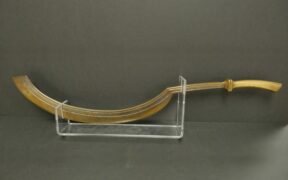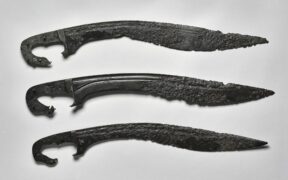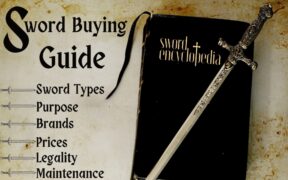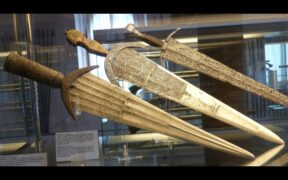Our content features commercial links to our products, committed to transparent, unbiased, and informed editorial recommendations. Learn More
The Kukri: A Comprehensive Guide to Nepal’s Iconic Knife
NO AI USED This Article has been written and edited by our team with no help of the AI
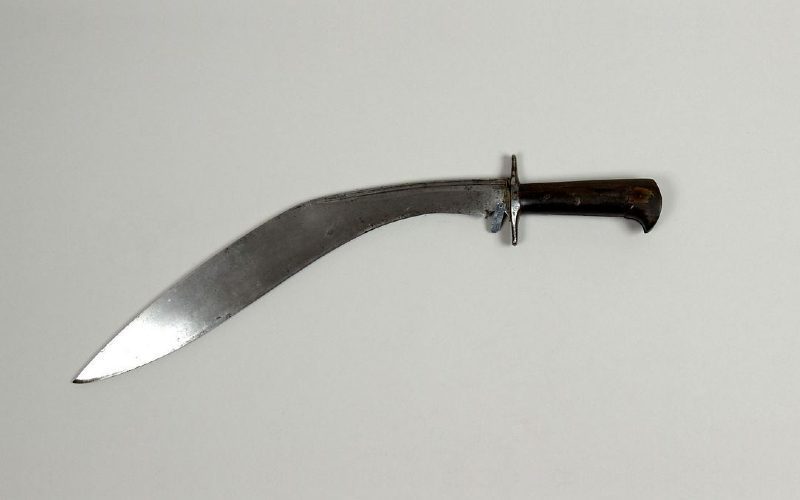
The Kukri sword, also known as the Khukuri, is a Nepalese sword with an internally curved edge. It is employed as both a weapon and a tool in Nepal. But, it is traditionally used by the Nepalese people as a basic utility knife.
The most important use of the Kukri sword is in the Nepalese or Gurkha army. The name Gurkha is closely associated with the Kukri sword. As it is the Gurkhas’ national and religious weapon, the Gurkha soldier is responsible for carrying the Kukri while awake and placing it under the pillow after retiring.
The Kukri is the national weapon of Nepal and has been used as a national symbol on the country’s coat of arms for most of its history. The Kukri sword comes with two smaller knives, the Kadra and Chakmak. Both knives are deeply rooted in myth and religion.
In this article, you will learn about the history, characteristics, types of Kukri, and the use of these swords.
Characteristics Of A Kukri Sword
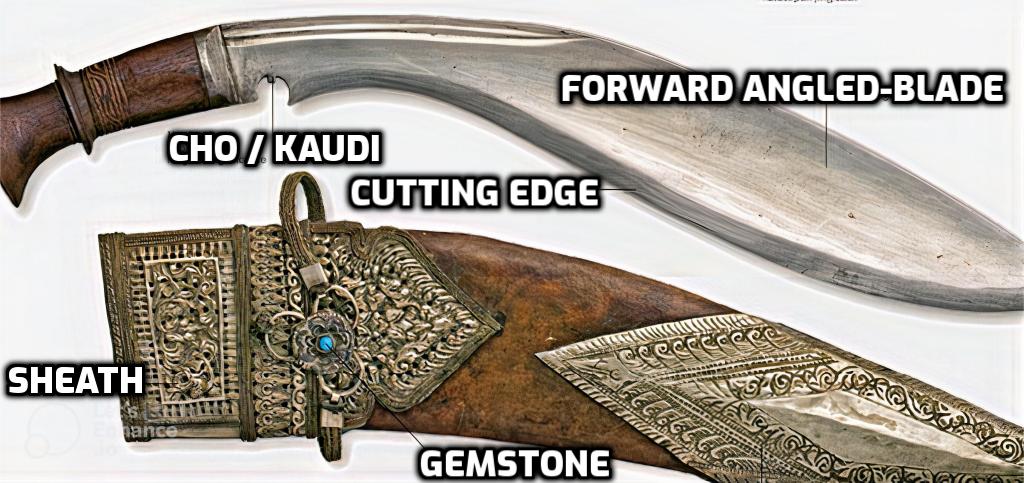
The Kukri sword is easily recognisable by the broadening of the blade, which curves up toward the end. The sword is sharp and narrows towards the tip.
The cutting edge is increased by its bending form and short edge. It was designed in this way to provide the most destructive power possible.
The Gorkhas will thrust the Kukri sword into their opponents’ abdomens or bellies, ripping them up with tremendous precision and speed. History has shown that the Kukri sword is so deadly because of these characteristics.
Blade

The unique shape of the blade makes the Kukri sword possibly the most devastating weapon ever.
The blade length is around 35 to 50 cm long but can vary. The Kukri blade usually is about 0.51 cm thick at its thickest point on the spine, sharpened on the down-curved/concave side but unsharpened on the top side (spine).
Depending on the type, a Kukri blade width ranging from 3 to 10 cm at its widest point is normal.
Weight
The Kukri sword weighs around 1kg. The classic and traditional Kukri weighs 900g, making it a convenient and easy tool to use in combat, especially in close quarters. It is also available in lighter variations of around 500g.
Scabbard
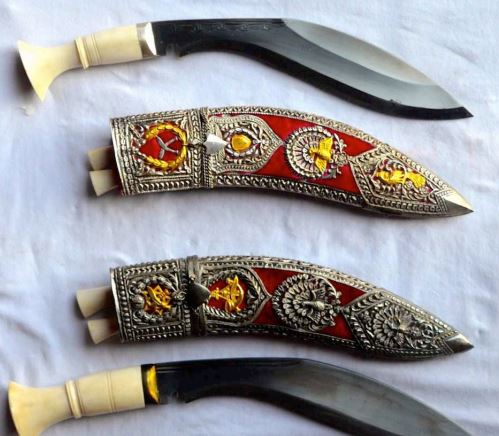
The Kukri sword, or Nepalese knife, is carried around in a scabbard. The blade can also be used as a prestigious and highly renowned weapon. Therefore, it must be displayed and presented in a unique-looking scabbard.
The scabbard, if decorative, is made from wood and covered with goatskin. A Sarki will most likely be assigned with creating the best-looking Kukri scabbard. Sakri is an ethnic group traditionally known for their ability as musicians, but they are also expert leatherworkers.
The Gurkha soldier usually places the primary Kukri in the scabbard along with two little 8 cm Kukris. The soldier uses the smaller knives to sharpen the main Kukri sword.
A departing officer is traditionally presented with a Kothimoda Khukuri (a silver case) to acknowledge his remarkable long and loyal service to his regiment and country.
Shape & Cho / Kaudi
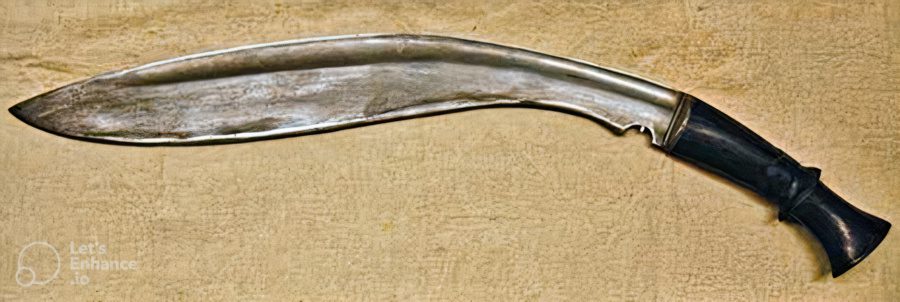
The Kukri sword is easily distinguished by its forward curving blade, which resembles a boomerang.
The main reason why it is formed in this way is to bear a resemblance to a crescent moon or the form of Nepal. Not only is the shape of the sword connected with many myths and meanings, but it also makes the Kukri sword more powerful when used for slashing.
There is also a little cut or notch at the base of the blade. This is called the Cho or Kaudi. This feature originates from the blood dripper tale. A blood dripper is a familiar tale that has a significant connection to Nepalese spiritual traditions and has a meaning in each faith and ethnic background.
According to various people, there are many other possible reasons for the Cho. It can be anything from the clitoris of Kali, Shiva’s penis, Surya ra Chandra – the sun and moon (Nepal’s emblems), a Kowdi – cow track since the cow is holy to Hindus, a replacement guard, blood dripper, and more.
Hilt & Handle
The Kukri sword features solid wood, horn/bone, or metal handle that is fastened with Himalayan epoxy (laha), riveted by screws/bolts in the handle, attached via the bolster and butt plate, or a combination of these methods.
This partial tang is the typical handle attachment in Nepal, while the stick tang has recently gained popularity. The complete tang is mostly seen in military versions. However, it is not widely used in Nepal.
Construction
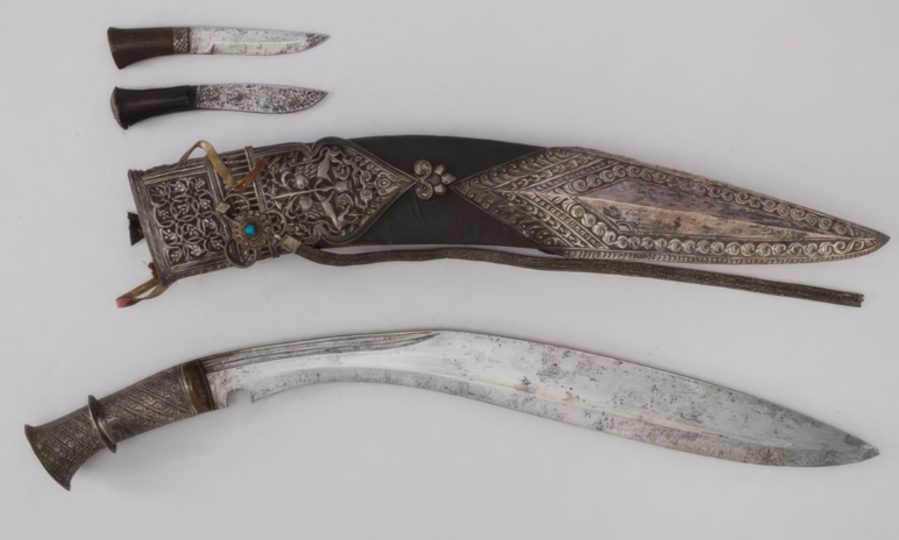
The Kami (caste) and Biswakarma (caste) are the main constructors of the Kukri Blade.
Moden Kukri blades are often made from vehicle suspension spring steel. The blade’s tang typically reaches all the way through to the handle’s end; the tiny bit of the tang projects through the handle’s end and is hammered flat to secure the blade.
The edge of a Kukri blade is strong and hardened, while the spine is softer. This allows it to keep a sharp edge while also absorbing blows. They are also balanced so that they will rest vertically if held on a fulcrum, such as a finger.
Traditionally, a two-man team does profiling of the blade’s edge; one operates a grinding wheel forward and backward through a rope wrapped multiple times around an axle. The other person sharpens the blade. The wheel is handcrafted from fine river sand and bonded by laha, the same glue that holds the handle to the blade.
Routine sharpening is typically achieved by running a chakmak over the edge in the same way chefs steel their knives.
Kadra & Chakmak
Kadra and Chakmak are the two smaller knife versions of the Kukri sword, which usually come as a package. They are utility tools intended to help with various things that the Kukri cannot do alone.
The Kadra is the bigger knife of the two and is meant for cutting smaller objects. The knife is most often used for skinning animals. Sometimes it is labelled as a paper-knife.
The Chakmak is the ‘right hand’ of the Kukri sword and is used as a sharpening tool for the Kukri Blade. Gurkha soldiers are never without it. It’s also used for starting fires.
What Is A Kukri Sword Used For & How Does It Work?
Kukri sword is a multifunctional implement used in the military, at home, and outdoors for working, hunting, cutting, hiking, clearing, chopping, stabbing, attacking, and fighting.
It has been used for generations in the thick Asian woods to chop through tough trees, cut big bushes clear to the ground, and much more. Older people also use the tool in their gardens, backyards, farming and more.
The Kukri sword has the ability of a machete, too – cutting down unpassable trees and shrubs and clearing out paths. It has many other outdoor uses and is even utilised by people in Western countries.
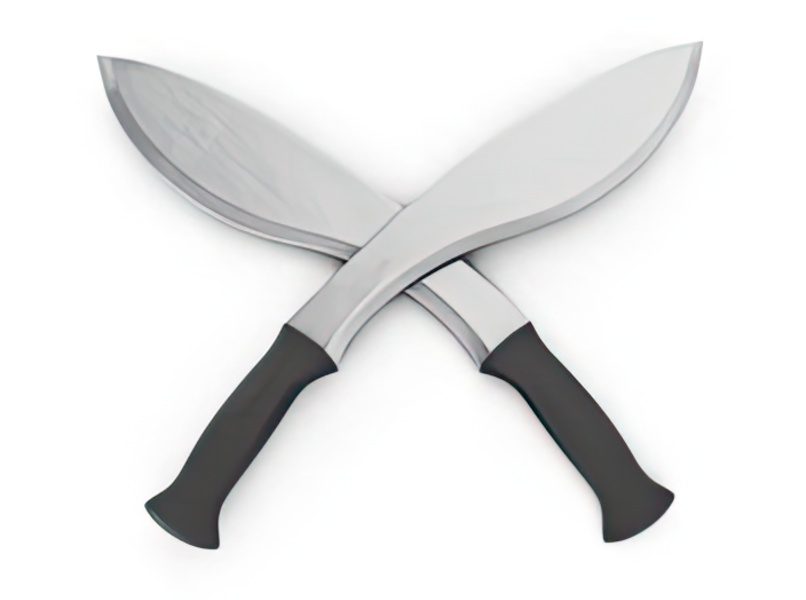
The biggest and most well-known characteristic is, of course, its destructive power as it is able to slice through flesh. There have been many instances where the sword was used to cut effortlessly through human and animal bones as if they were feathers.
One tale is that when a Ghorka was fighting his enemies, the enemy would say, ‘Ha! You’ve missed me!’ to which the Ghorka with the Kukri sword would reply, ‘Try moving your head.’
Another report is how a Gurkha warrior with a Kukri defended himself. On September 2, 2010, a Gurkha warrior was heading home after retiring from the Indian Army when he was confronted by 40 armed thieves. He took out his Kukri and attacked them single-handedly, killing three and wounding eight more.
Types Of Kukri Swords

Kukri swords are widely categorised into two types: Siropate and Budhuni.
The Siropate knives have sleeker and thinner blades. They are often used for combat scenarios because they are lightweight yet extremely sharp.
By contrast, the Budhuni knives have larger, wider blades shaped more like fish. They have also been used in combat and as survival knives; however, most are used in normal daily activities.
Other types of Kukri swords differ only by the shape of the blade, such as the Tikho, Majaulo, Sanglo, Sojo, Chaaklo, Kupro and Thulo.
Best Kukri Swords Available On The Market
In modern times many swords or knives use the name Kukri because they are curved like the Kukri swords. However, they are often Bowie knives.
Finding a real quality Kukri sword is not that easy. This is our collection of the three best Kukri swords or Kukri knives we’ve seen on the market.
1. Best Overall – Gurkha Kukri
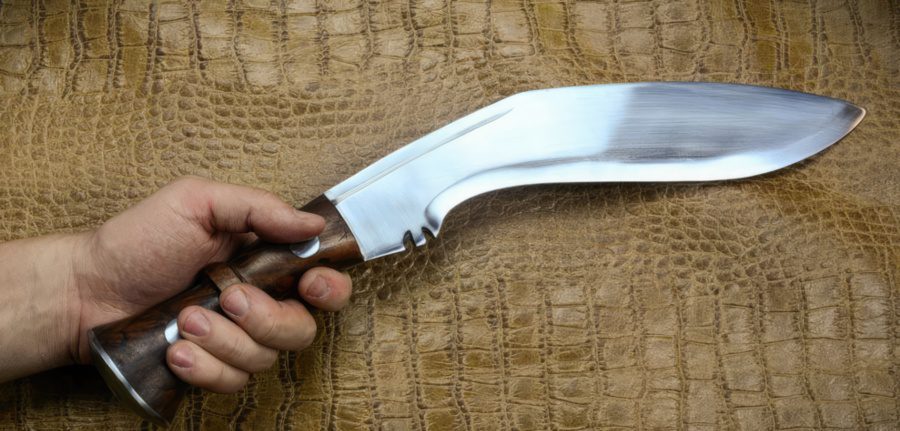
The blade of this Gurkha Khukuri is unsharpened and fashioned from high-carbon steel. It has a sturdy spine allowing it to power through its attacks and can produce powerful chops and cuts.
The grip is made of wood composite that is dual-riveted to the large blade tang. This guarantees that the Kukuri has a sturdy overall construction. The grip is finished with a steel pommel cap.
The Khukuri comes with a leather-bound wooden scabbard with a brass cap. It may be worn from the belt using a pair of riveted leather hanging loops. These types of Kukri’s can be found at a surprisingly affordable price!
2. Best For Hunting – Khukri Knife
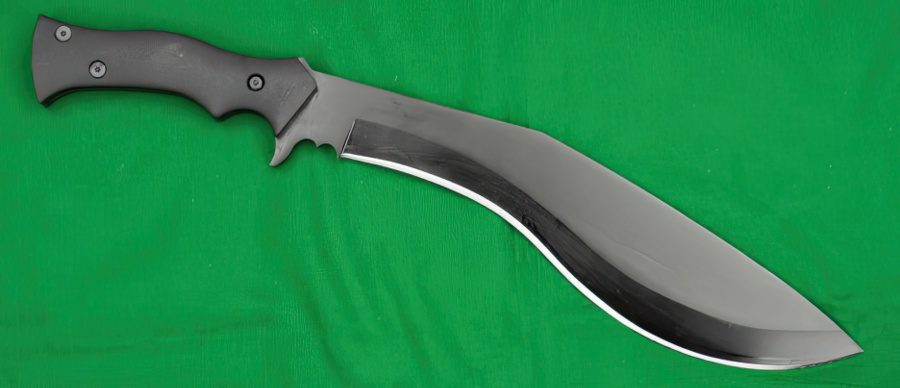
The A.P.O.C. Khukri knife combines the strong chopping shape of the Kukuri knife with highly durable contemporary materials and construction to produce a knife that is designed for survival and defence. It is an excellent tool to have on you if you are hunting.
The blade is made of black-coated high carbon 9260 steel with a fantastic edge hardness. The blade’s spine is relatively thick, befitting a Kukuri, giving it the bulk needed to cut through a target in a substantial cleaving chop.
The hunting Kukri swords may be hard to come by but are relatively inexpensive.
3. Best For Budget – Military Service Kukri Sword No.1
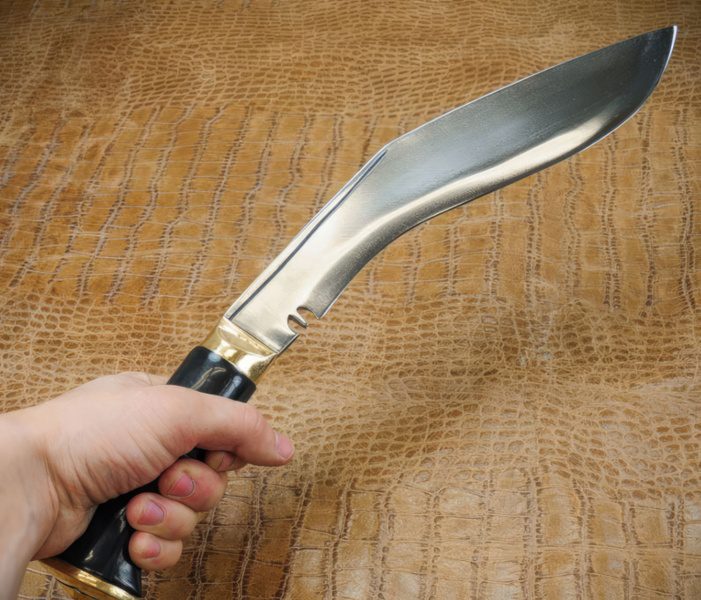
This Military Service No. 1 Kukri sword is made with a differentially hardened 5160 high carbon steel blade. The blade boasts a dull-resistant edge hardness, a body hardness of 45-46 HRC (hot rolled coil – steel), and a softer shock-absorbing spine hardness.
Service No. 1 and Service No. 2 Kukris are issued to Gurkha troops. Service No. 1 is designed to be the Gurkha’s ceremonial blade. It is simple, graceful, traditional, and a fine, low-budget blade emblematic of both the Gurkha and Khukuri.
History Of The Kukri Sword
The Kukri is an ancient weapon. The first examples date from the mid-16th to early 17th centuries. Its origin is possibly related to similar blades used in ancient Egypt, Greece, and the Roman Empire.
The Kurki Sword Through The Ages
The Kukri sword originated from an ancient era. It is directly connected to Alexander the Great’s soldiers invading the East (toward India). Some say it was possibly sourced from the Hellenic Kopis sword and brought to India.
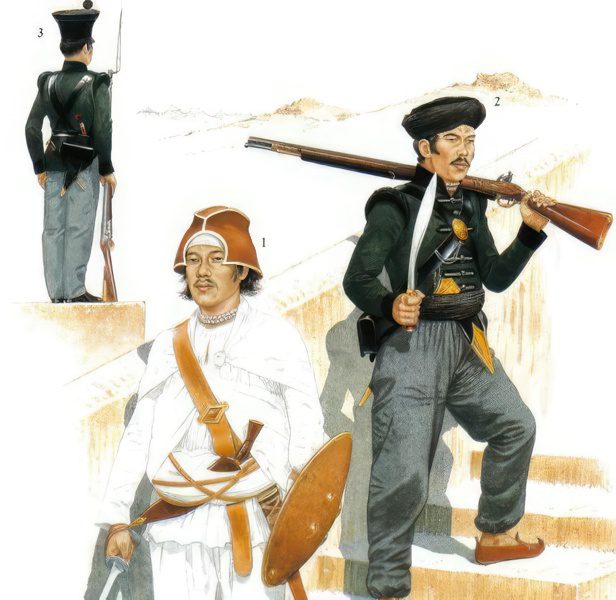
Later, Hellenic monarchs in Afghanistan and India, who had contact with the Mediterranean culture, appeared to have used and maybe promoted Kukri-like implements (This is after Julius Caesar and the Roman merchants, who had a large economic presence in India).
Some say that the Kukri sword comes from the Egyptian Khopesh. This ancient Egyptian sword was heavily used in combat and highly effective because of its sickle shape. It is also very similar to the Kukri sword but much bigger.
The oldest Kukri sword dates from the 16th century and is kept in Nepal’s National Museum. However, the question remains whether the Kukri sword came from India with its conquests or originated in Nepal.
In the mid-16th to late19th centuries, the Turks used a form of forward-curving Turkish sword called Yataghan, which appeared centuries after the Battle of Manzikert (the biggest battle against the Eastern Roman Empire) and looked similar to the Kukri sword.
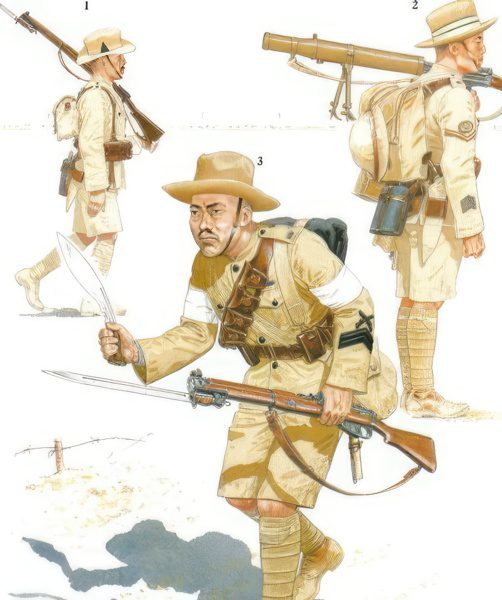
The Kukri sword was also used to a great extent in almost every modern war. People might assume that this sword isn’t very effective because rifles are more commonly used, but Japanese soldiers from World War 2 would disagree.
The Kukri, capable of severing an enemy’s head in a single stroke, was particularly dreaded by the Japanese during World War II.
British Empire
The Kukri sword was commonly employed by the Gorkhalis in the 18th century and became known to the British in the late 18th century.
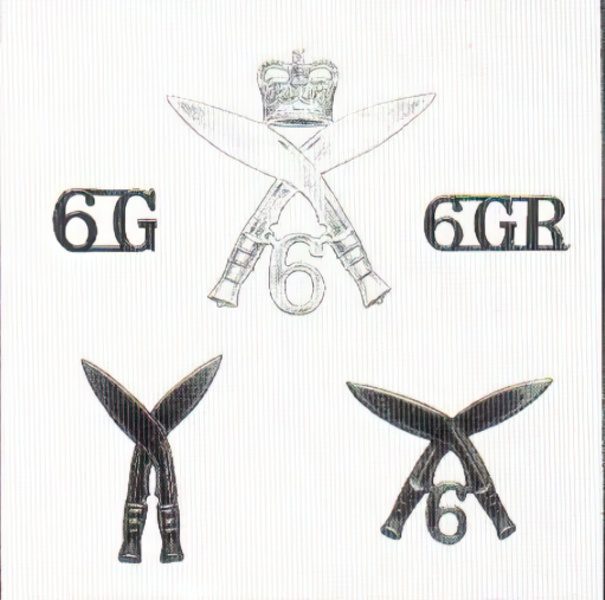
The Kukri was created after the AngloNepal War of 1814-1816 and at the beginning of the recruitment of the Gorkhalis into the Colonial British Indian Army. Since then, it has since been used by Gurkhas/Gorkhas worldwide.
Since 1815, the Kukri has been utilised in all significant conflicts and engagements in which the British have sent Gurkhas. The Gurkhas with the Kukri have been in service of the UK through wars like Afghanistan, the Balkans, Burma, India, WW1 and WW2, and many more.
Gurkhas
The Gurkhas are a people from Nepal and northern India who are noted for their unwavering bravery. They were recruited by the British East India Company in the nineteenth century and continue to serve in British armies to this day.
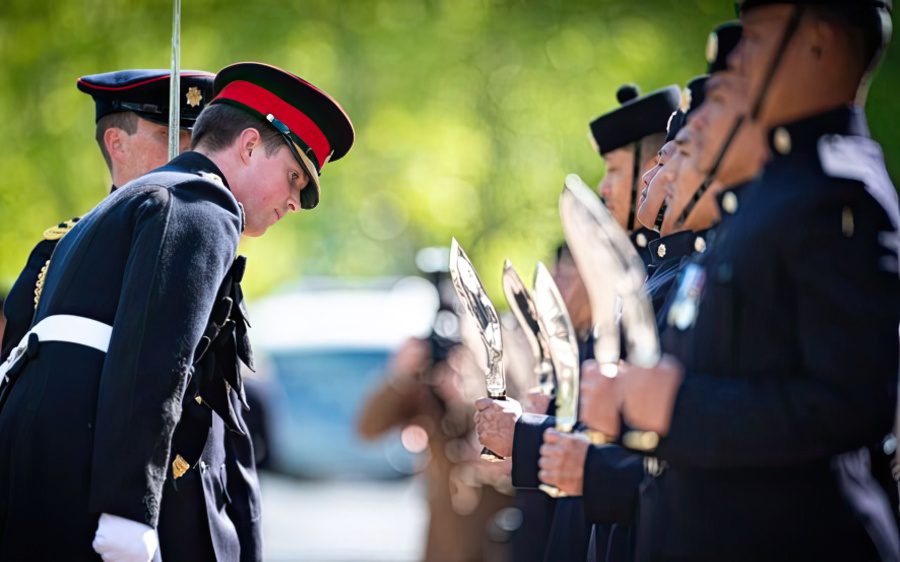
The Indian Army has six Gurkha regiments, whereas Nepal has two Gurkha battalions. The Kukri is the most well-known weapon of the Gurkhas.
Myths
Myths and beliefs surround the Kukri knife. The beliefs are firmly rooted in the Nepal tradition and culture and persist to this day.
The biggest and most common belief is that a Kukri sword shouldn’t be placed in the scabbard if it isn’t ‘washed’ with your enemy’s blood. However, the Kukri knife is used in ordinary lives and does not involve killing.
Another myth is that when thrown, the Kukri blade could disarm an opponent and return the enemy’s weapon back to your own hands. This is strongly seen in the mythology of Nepal and India.
Beliefs & Religion
The Kukri sword is closely connected to religion and beliefs, making it a remarkable weapon.
According to a belief passed down through centuries, a Khukri kept at home will bring wealth and prosperity and chase away evil spirits. The Khukuri is said to have the spiritual ability to ward off demons, evils, and nightmares and is therefore put under the pillow of a man or child with a sleeping problem.
The sword is strongly connected with respect too. When a sacrificial ritual takes place, a Kukri sword is generally used. When someone retires, he is given a proper decorative Kukri knife. Kukri knives can also be gifted for weddings and childbirth ceremonies.
So as you can see, it has many more functions than the ‘do or die’ kind of function that some see in the Gorkha Army.
Usage Of The Kukri Sword
Despite its outward resemblance to a boomerang, the Kukri sword is not intended to be thrown. The unique forward drop of the blade is designed to function as a weight on the end of the blade, causing the Kukri blade to fall on the adversary faster and with more force.
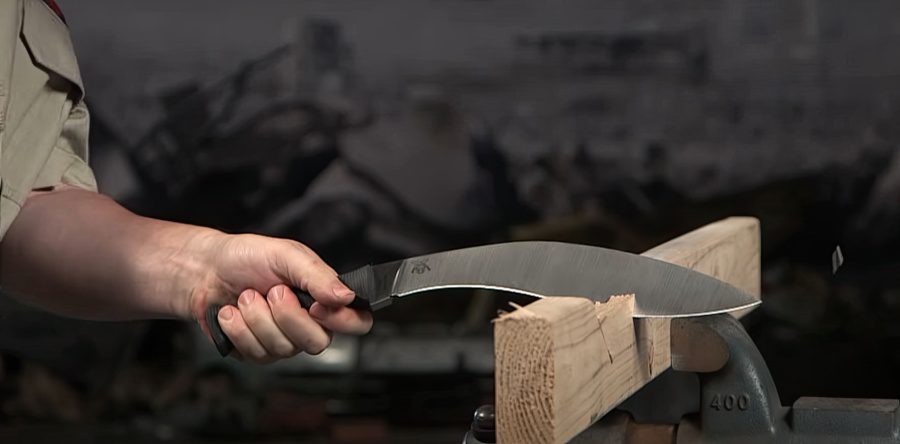
It has been incorrectly reported that the knife is particularly weighted for slicing through the throat. The Kukri is most efficient as a chopping and slicing weapon. However, it is occasionally used for stabbing.
To see how the Kukri sword actually works and functions, watch Cold Steel on YouTube.
Is Kukri A Sword Or A Knife?
The Kukri can be placed in the sword category just because of its background. However, it has many other uses beyond the knife category and daily activities.
“A Khukuri is much more than just a knife” is something you’ll hear from historians and professors from Nepal. Even the daily farmer would agree and say the same thing.
The Kukri has a remarkable history and deep roots with lots of culture and tradition tied to it. Therefore, calling it a sword would be much more appropriate than calling it a knife.
A knife is a tool we use in daily activities, something we can do with the Kukri. But a sword is used for freedom, fight and struggle. The Kukri represents hope.
At times, people still call it simply a big knife or a shortsword. However, it should perhaps be placed in a different category.
Is The Kukri Sword A Machete?
Maybe. Some would argue that the Kukri machete is the closest definition for the Kukri and that it cannot be placed in the sword or knife category.
Machetes are instruments that purposefully shift the balance point away from the hand. They aren’t meant to parry. Moving the balance further out, on the other hand, concentrates on increasing power.
According to this definition, the Kukuri is a modified machete for battle. It is not intended to parry like a sword but rather to eliminate an opponent in a series of deadly assaults before they have a chance to react.
Conclusion
The Kukri sword is regarded as one of the most effective and interesting swords and has gained a lot of interest from sword collectors. Despite the urban mythologies and stories of its destructive power that a Gurkha “never sheaths his blade without first taking blood,” the Kukri is most typically used as a multi-purpose utility instrument, similar to a machete. It remains the most prestigious item for a household in Nepal.
This saying is still used to this day in Nepal: “A man with a Khukuri is a man of honour, dignity, courage, and loyalty.”
